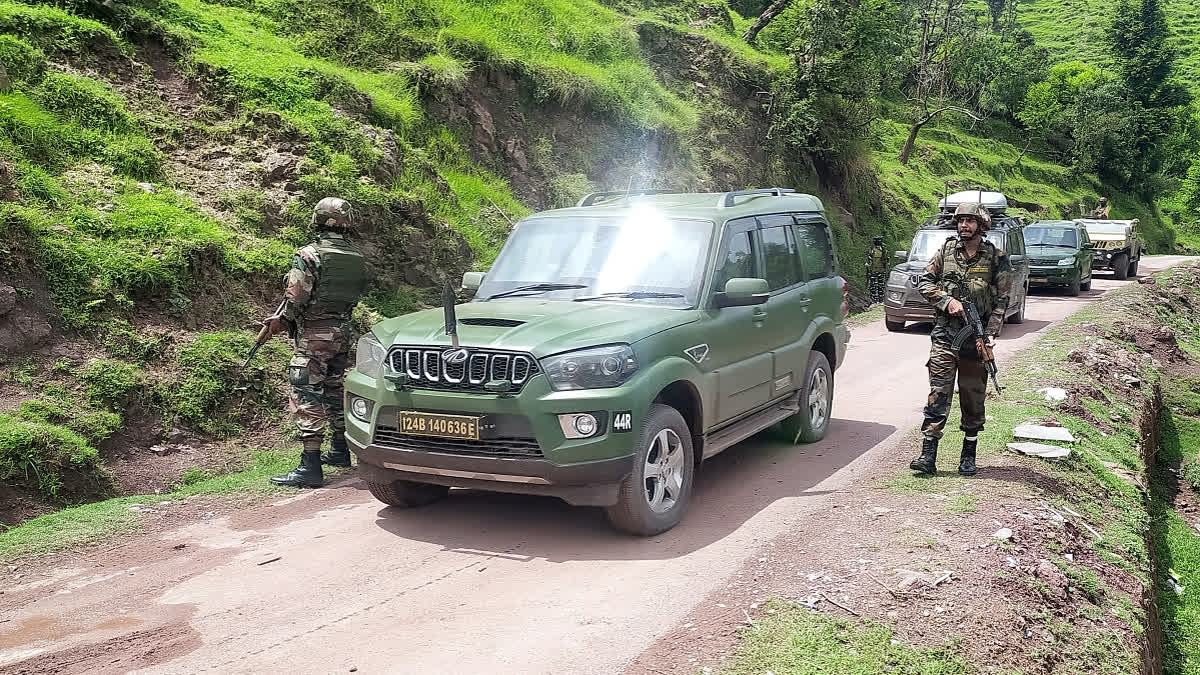There has been a surge in terrorist activities in the Jammu belt in the past few months. Most have resulted in disproportionate casualties to security force personnel, leading to a backlash across political and social media circles. The government and indirectly, the security forces, are under pressure to deliver. Simultaneously, there has been a reduction in terrorist actions in the valley. This does not indicate that terrorism has died down in the region but that it has been contained, at least for the present.
Pakistan-sponsored terrorism, faced by India in Jammu and Kashmir, cannot end unless costs to the sponsors are made prohibitive. Talks will never be a solution as there is no common ground between the two nations. Terrorism will move from regions where security forces' presence is high to regions where it has diminished. This is a natural process and one of the causes of increased terrorism in the Jammu belt.
Terrorists will also select terrain which offers them maximum advantage. In this case, dense jungles, caves as hideouts and proximity to the Line of Control (LoC) favour the terrorists. In such terrain, force multipliers like drones, which provide live inputs, have limited utility. Visibility remains restricted. In addition, there is a presence of few supporters, largely influenced by financial gains and possibly even ideology, providing guidance, logistics and advance information on the move of security forces to terrorists. This prevents them from being completely isolated and makes operations against them challenging.
There were political statements, largely during recently concluded elections, that the scenario has improved to levels where the government was considering lifting AFSPA (Armed Forces Special Powers Act) in a few regions. There was a rumour that a few companies in Rashtriya Rifle battalions could be reduced as part of the right-sizing of forces. These were rushed assessments.
Post the intrusion in Ladakh, some troops from the Jammu sector were inducted on the assumption that terrorism had subsided and readjustment was feasible. This was a hurried measure based on short-term assessment. Their movement resulted in voids which were exploited. Hence, while those moved out would not be brought back, additional forces are now being deployed.
There is also the need to look at terrorism in Jammu and Kashmir from a broader lens. Scenarios have been worse and ultimately retrieved. However, it takes patience as also operations cannot and should not be rushed. Invariably these commence with casualties to those combating terrorism as the pendulum slowly swings in their favour.
Anti-terrorism operations cannot be resolved solely by enhancing force levels. Establishing an intelligence grid, domination of terrain and relentless pursuit will ultimately change the game. Inducted troops will need time to be trained and familiarised, so as to ensure casualties are minimum. Intelligence grids need to be reactivated. Reports also mention the deployment of special forces, fairly familiar with the terrain and expected nature of operations. They will be force multipliers.
Local Village Defence Guards, well versed with the terrain, including possible hideouts, are being incorporated. Electronic monitoring will gain credence, though hampered by new technology equipment employed by terrorists. This would take time to break. The anti-terrorism grid would be strengthened to reduce possible infiltration attempts. Overground workers would be sidelined and terrorists isolated from their supporters. This implies that operations would be deliberate and implemented based on a plan, involving all elements of the state.
Simultaneously there is a need to ensure that own civilians do not become casualties. In earlier operations in this sector in 2003-04, local herders were prevented from moving into the hills. This helped in further isolating the terrorists. Wonder if the same can be resorted to at present. The government would desire minimum inconvenience to locals.
The Amarnath Yatra is progressing at the same time. Emphasis on its security remains an added concern. While troops employed for sanitising the Yatra route are not the same, however, the intent remains that there be no untoward incident during its conduct. The yatra is also a lifeline for the people of the Union Territory (UT), with those assisting the pilgrims coming from all parts of the UT. Their annual livelihood depends on its safe conclusion.
Security force casualties at the hands of terrorists hurt the nation. This is expected. However, this is not the time to criticise or pressurise the forces. Nor should the nation expect miracles. These operations involve patience and detailed planning. It must be remembered that inducted terrorists have no way of returning to Pakistan. They are here to continue to target till they are eliminated. Theirs is a one-way ticket.
At the national level, we need to clearly enunciate our red lines. The cross-border and Balakote strike conveyed the nation's determination but their impact died with time. There is a need to once again send a clear message. Drawing political mileage from past operations as also threatening to hit back during election campaigning is not the solution. Unless displayed repeatedly, these remain just political slogans.
We need to comprehend Pakistan's intent and counter it. Currently, Pakistan is compelled to concentrate on its western provinces to satisfy Chinese demands of eradicating terrorist threats to the CPEC. Thus, available forces are deployed in counter-terrorist operations in Khyber Pakhtunkhwa and Baluchistan. Operations there are not moving as per plan, with casualties to Pakistan forces increasing. Tensions are on the rise with Afghanistan and war is imminent.
Increased terrorism in Jammu and Kashmir is intended to keep India engaged internally, letting Pakistan conduct its operations without interference. Pakistan is also banking on India’s tensions with China along the LAC. It believes that this will prevent it from retaliating. There is no doubt that China and Pakistan are operating in unison. It is this that India must counter.
There are options before the government. Disregarding the ceasefire along the LoC and targeting Pakistan’s posts, and terrorist camps, even if they are in villages, is one option. But will this impose caution is the question? Will China attempt to support Pakistan by activating the LAC is a possibility. This is an assessment that the government will have to do. The next option is a cross-border strike. Here again, the government must be prepared for an escalation.
The fact remains that the message has to go. How will it be conveyed is the government’s decision.
(Disclaimer: The opinions expressed in this article are those of the writer. The facts and opinions expressed here do not reflect the views of ETV Bharat)



